I am not sure has anyone else noticed a worrying trend in contemporary dance where there is a use of black out etc but also lots of gloomy , obscuring lighting and you can barely see the dancers who are working very hard but you can hardly see the choreography ?
Wednesday, 28 December 2016
Summer Rain at the New
A fine performance http://performing.artshub.com.au/news-article/reviews/performing-arts/lynne-lancaster/summer-rain-252677 This is a rare chance to see this great Australian musical: It is Christmas 1945, charismatic Harold Slocum – actor/manager and head of Slocum’s Travelling Family Tent Show – has a love of gambling and (with a lack of funds) is unable to pay his troupes. After the performers walk out, the Slocum family ends up in the drought-blighted NSW outback town of Turnaround Creek – where it hasn’t rained for a Biblical seven years.
Putting on a show, the Slocum family draw on the enthusiasm of the townspeople, despite the hostility shown by local publican Barry Doyle, who remembers – 16 years earlier – the last time Harold was in town (and why is Barry Doyle so hostile? All is revealed later).
Suddenly the drought breaks (with a joyous 'Send 'er Down, Hughie!') and the Slocums are stranded while staying at the Shamrock Motel. Over the nine relentless days of rain, hidden memories are revealed; emotions run undoubtedly high, and new life is breathed into the town with the birth of baby Nancy. Love also blossoms for the Slocum's daughter Joy and a more optimistic atmosphere with the start of 1946 and the end of long years of war cautiously starts to take hold.
Trent Kidd, director and choreographer, does a splendid job of bringing this whimsical, rather melancholy and moving show with its large cast of seventeen to life. The set design by Mason Brown was fluid and flexible and was most impressive. Painterly, atmospheric and evocative it had the feel of a one horse outback town straight out of a Dobell or Drysdale painting. The extended number in the first half 'Nothin‘ Doin’ captures perfectly the enervating heat right on Christmas with the townspeople bored and barely able to move. The lighting by Juz McGuire was also splendid and the greatly detailed costumes (also by the talented Mason Brown) were impressive too.
Musically, it ranges from Operatic to Vaudeville with touches of Sondheim. It is a pity the orchestra was hidden the whole time behind a curtain and there was no acknowledgement of Tim Cunniffe and his team at the end. There is much fun with, for example, the sultry 'Tango D’Amour', while musicals such as Singin’ In The Rain were echoed in 'Watch the Puddles There', there are beautiful ballads too 'Casuarina Tree' and ironic comments 'You Might Miss the Mongrel' about men with shades of Chicago in the mix.
Choreographically it also ranged from Vaudeville to Fred and Ginger style, as well as big musical full cast production numbers and also old style social dances requiring the cast to be extremely versatile.
Andrew Sharp strongly anchors the show as the dynamic Harold Slocum who has gentle humour and a great rapport with his colleagues but is torn and tired underneath. As Ruby Slocum, Harold’s second wife and female head of the troupe, Jacqui Rae Moloney is vibrant, captivating and full of panache. Will she leave Harold?Catty Hamilton as strong and feisty Joy Slocum is enchanting – a terrific singer and dancer especially in the delightful dances with handsome Nat Job as charming Clarrie Nugent. Anna Freeland as Peg Hartigan Barry’s eldest daughter working at the Shamrock and married to Mick, was glorious, sensitively portraying and bringing her to life with passion, charm and commitment. Her voice is terrific, luscious and assured. Barry Doyle was portrayed by Laurence Coy with hidden menace but unfortunately he lacked lustre in the vocal department for his big songs.
A terrific show that deliberately references Hollywood and Australian traditions, celebrating the vaudeville troupes which travelled outback Australia in the 1930s and 40s and the tight-knit rural communities they entertained; Summer Rain ends on a cautiously optimistic note.
Rating: 4 stars out of 5
SUMMER RAIN
CREATIVE TEAM
Director/Choreographer Trent Kidd
Musical Director Tim Cunniffe
Set and Costume Designer Mason Browne
Lighting Designer Juz McGuire
Associate Musical Director Glenn Moorehouse
Assistant Director/Assistant Choreographer Caroline Mooney
Production Manager/Stage Manager Jo Jewitt
ASMs Christine Ciuciura, Jessie Huang, Becky Matthews
Operator Martin Gallagher
CAST
Rebecca Burchett, Daisy Cousens, Laurence Coy, Anna Freeland, Catty Hamilton, Tom Handley, David Hooley,
Nat Jobe, Jaimie Leigh Johnson, Michele Lansdown, Joy Miller, Jacqui Rae Moloney, Clare Ellen O’Connor,
Brett O’Neill, Steven Ritchie, Andrew Sharp, Chris Wilcox.
Summer Rain by Nick Enright and Terence Clarke
New Theatre
15 November until 17 December 2016
SUMMER RAIN
CREATIVE TEAM
Director/Choreographer Trent Kidd
Musical Director Tim Cunniffe
Set and Costume Designer Mason Browne
Lighting Designer Juz McGuire
Associate Musical Director Glenn Moorehouse
Assistant Director/Assistant Choreographer Caroline Mooney
Production Manager/Stage Manager Jo Jewitt
ASMs Christine Ciuciura, Jessie Huang, Becky Matthews
Operator Martin Gallagher
CAST
Rebecca Burchett, Daisy Cousens, Laurence Coy, Anna Freeland, Catty Hamilton, Tom Handley, David Hooley,
Nat Jobe, Jaimie Leigh Johnson, Michele Lansdown, Joy Miller, Jacqui Rae Moloney, Clare Ellen O’Connor,
Brett O’Neill, Steven Ritchie, Andrew Sharp, Chris Wilcox.
Summer Rain by Nick Enright and Terence Clarke
New Theatre
15 November until 17 December 2016
From Sand to Stage
The 40th Anniversary of NAISDA . Here's what I said for Dance Informa http://dancemagazine.com.au/2016/12/from-sand-to-stage-honors-40th-anniversary-of-naisda/
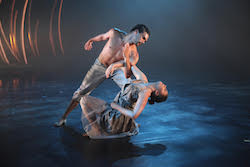
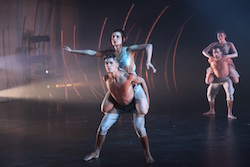
Carriageworks, Sydney.
November 19, 2016.
November 19, 2016.
Celebrating the 40th anniversary of the National Aboriginal and Islander Skills Development Association (NAISDA), From Sand to Stage also examined the development of NAISDA within the broader context of the development of Aboriginal activism and protest in Australia.
The production was devised in three parts: Past, Present and Future, combining newly commissioned works from three guest choreographers, some vintage works from Carole Y. Johnson (one of NAISDA’s key founding figures) and student works, and concluding with some traditional Aboriginal dances and songs of the Yolngu clan from North East Arnhem Land with their traditional Banumbirr (Morning Star) pole.

NAISDA’s Jonathan Brown and Kassidy Walters. Photo by Michelle Blakeney.
Sometimes, the work felt a little jumbled and messy. In parts, it was perhaps difficult to follow the narrative thread and to tell where one section ended and the next one began. But overall, From Sand to Stage was extremely impressive and the performances outstanding. The dancing overall was extremely impressive.
The accompanying printed program that was available was most informative, providing a historical background and context to NAISDA’s emergence as a training institution in the 1970s, as well as choreographers’ notes that helped to clarify the symbolism and intent of some of the works. As a school, NAISDA’s dancers are more diverse in build, technique and style than the graduates of many other tertiary dance programs, which is great.
There was a lot of anger and turbulence, from the reworking of the Embassy of the 1970s as reimagined by Vicki Van Hout through to current times with references to Bill Leak’s controversial cartoon and the recent Kalgoorlie violence. Van Hout’s work included the creative use of props (a vacuum cleaner pipe used as a didgeridoo, for example!), including tent-like structures that fluidly shifted, controlled and restrained the dancers’ movement — at times like a ship with sails, at others like a bulging camel. The way Aboriginals/TSI people are treated and insulted was included with all sorts of awkward, impolite questions being asked in the line-up at the microphone. There was a section where cans were used as a wall, and this developed into references to glue sniffing by young people.
Johnson’s Brown Skin Baby solo (danced with haunting grief and power by Coleen Jerrard), with its Graham-style choreographic influence and a cry from the heart for the Stolen generation, also reminded us of the African-American tradition of dance activism that was a crucial part of NAISDA’s early years. Omer Backley-Astrachan’s Blinders (choreographed in conjunction with Certificate III students) is a striking, compelling work, and the combination of Elvis Presley’s melancholic “I Can’t Help Falling in Love” with glorious photos of the Australian landscape made a lasting impression.
NAISDA alumnae and Bangarra Senior Dancer Elma Kris remounted extracts from two iconic works, ‘Emeret Lu’ and ‘About (Belong)’, originally created for Bangarra Dance Theatre. Photo by Michelle Blakeney.
Also included were excerpts from Elma Kris’s Emeret Lu and About, originally created for Bangarra Dance Theatre, which showcased the trademark Bangarra blend of lyrical contemporary and Indigenous dance at its best. Later, the solo by Jonathan Brown, Dark Side of Me, was a highlight, with its dark splintered menace and fractured despair.Institution, with its chilling atmosphere of Lowood, was haunting for its evocation of how the stolen generation of Aboriginal women were harshly treated.
The lighting for all of the works was extremely effective. There was also an exhibition linked in which had fascinating posters, photographs, newspaper clippings, videos and other memorabilia charting the history of NAISDA.
From Sand to Stage was most exciting programme showcasing some wonderful graduating talent. Looking forward to many more years for NAISDA!
By Lynne Lancaster of Dance Informa.
Australian Ballet School showcase at the Sydney Opera House
Here's what I said for Dance Informa
http://dancemagazine.com.au/2016/12/22502/
Joan Sutherland Theatre, Sydney Opera House, Sydney.
December 4, 2016.
December 4, 2016.
After a gap of a decade, the Australian Ballet School brought its end-of-year showcase to Sydney. We were privileged to see some glorious dancing; there is certainly a lot of blossoming talent in the school.
The opening work was A Time to Dance choreographed by Australian Ballet alumnus Stanton Welch (who is now director of the Houston Ballet). It was abstract, an excuse to display the tremendous dancing of the Level 8 dancers to music by Antonín Dvořák. The female dancers wore long skirts and embroidered stomachers and the men had an embroidered belt, all in a folk/character dance feel in mainly autumnal colours. The young men showed off their fabulous jumps, leaps and turns, the young ladies their intricate pointe work and dazzling pirouettes. The partnering was quite demanding. At times, the choreography was reminiscent of Frederick Ashton and George Balanchine. There was lots of fast fleet footwork, exuberant runs and some difficult high lifts and sudden drop catches. One of the dancers had a Tzigane-like fiery solo.
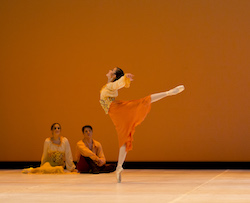
Stanton Welch’s ‘A TIme to Dance’. Photo by Sergey Konstantinov.
The second work was Graeme Murphy’s Almost for six of the Level 7 dancers. It was the only work that featured live music (John Tallis’ The Fantasy for Violin and Piano). Almost contained classic Murphy genius choreography requiring long diagonal body lines, soft jumps (some of them almost death-defying) and sinuous, very demanding lifts. If you know Murphy’s works, you could pick up tiny snippets of choreographic phrases from Daphnis and Chloe, After Venice and Some Rooms, for example. Almost was dreamlike and passionate – was the young man mourning the break-up with his girlfriend who takes up with another young man (his best friend?) And who were the two young ladies who were almost twins and dressed in almost matching dark floral dresses?
Invisible Icon, choreographed by Margaret Wilson, was strong and impressive with its relentless, compelling, trance-like chants and dynamic sculptural blocks of movement. It was like a ritual dance performed as worship in a steamy jungle. At times, it reminded me of Maurice Béjart’s work. Lunges, runs, rippling arms and the Murphy “walk” were also included. The young men were topless in their dark grey/green leggings. The only female (Tene Ward), in a matching unitard, was in some ways the leader of the group. It was a spectacular showcase for the men, showing off their feline jumps, with a couple of marvellous male pas de deux and a frenetic Puck-like solo. Ward’s solo was sultry and exotic.
A Singular Sequence, choreographed by Stephen Baynes to Igor Stravinsky, also had Balanchine style references. The work was neoclassical with a twist. It was coolly classical in beautiful blue leotards. The opening quartet was most impressive; long lines and tender, intimate partnering were required in other sections. It was as if the women were at first aloof. The men interrupt and have polite, rather formal conversations, and then eventually the four couples really get to know each other.
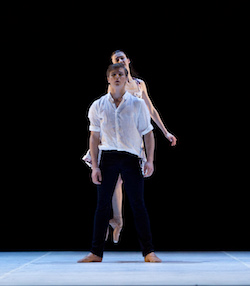
Graeme Murphy’s ‘Almost’. Photo by Sergey Konstantinov.
The last, rather long, extended work was Divertissement, choreographed by Simon Dow to assorted Giuseppe Verdi opera selections. It was an abstract extended showcase of classical technique, referencing the “ballet blanc”. (Think the huge corps de ballet of swans, snowflakes or willis, for example, or the vision scene in La Bayadère or Serge Lifar’s Suite En Blanc.) The young women were in two different sorts of white tutus — one rather plain, the other diamond-encrusted and with a curling fancy headdress. The men wore black tights with a white shirt, some also with a black waistcoat. There were very showy and spectacular leaps and turns for the young men, lots of organised blocks of criss-crossing patterns of choreography for the young women. The young women had beautiful épaulement and fluid port de bras. Some of the short solos were amazing, showcasing lots of fouettés or grande tours à la seconde.
At the end, the entire cast of the Showcase appeared, in an equivalent of the Grand Defile of the Paris Opera Ballet.
By Lynne Lancaster of Dance Informa.
Sydney Dance PPY 2016
A most exciting evening .Here's what I said for Dance Informa http://dancemagazine.com.au/2016/12/sydney-dance-companys-pre-professional-year-shows-great-potential/ Carriageworks, Sydney.
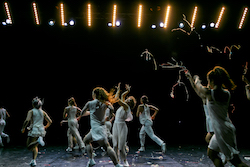
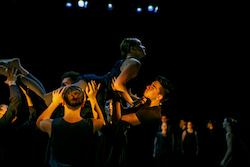
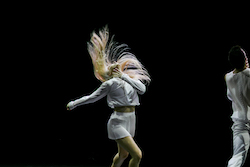
December 7, 2016.
Sydney Dance Company’s Pre-Professional Year (PPY) 2016 Season showcased some very exciting performances and great talents of the selected dancers of the PPY. There was a fascinating range of contemporary styles of choreography and some excellent performances.

Sydney Dance Company’s PPY. Photo by Gez Xavier Mansfield Photography.
Corporare, choreographed by Thomas Bradley, opened the programme and utilized nine dancers. Directed improvisation was used to find exterior motivations for the dancers’ physicality. This morphed into props such as ropes, ties and jackets, making us notice the distorted restriction and deformation that these enforce on the human body. The lighting was also often restricted, with just a small corridor of light or a snapping on and off. I have noticed this as a trend lately in several performances, but this use of lighting made it so dark that it was hard to see the dancers. The music beeped, clicked, thrummed and throbbed, and vocalisaton was also included. As we entered and took our seats, the dancers were already on stage — one young man apart from a group in a curved “S” shape. It was as if the lone man is threatened by the group. Small, tiny movements — of the shoulders, hips or face — were used at first. There were some intriguing lifts, rolling floorwork and excellent partnering. The work also had a Butoh feel at times.
The second work was the striking, impressive and very demanding Pieces of Cella, choreographed by Narelle Benjamin. The piece was short and dream-like. This evening’s performance featured the second cast, Amber Jackson and Lisa McLaughlan. It was performed in unison and was as if they were mysterious mermaids underwater with their long, rippling hair. The cast were barefoot and wore casual grey/blue rehearsal clothes. Long, stretched and rippling arms were required of the dancers, as was an almost contortionist flexibility.

Sydney Dance Company’s PPY. Photo by Gez Xavier Mansfield Photography.
Zachary Lopez’s rather puzzling Like a Salmon in the Saharaopened with blinding, flashing lighting effects. Strobe lighting and blackouts were also included. The cast were all in white, each costume slightly different. Isabella Bonanno as the runner runs on the spot constantly for the entire work. Lopez’s work is frenetic, with lots of runs. It is meant to be about “imagining a space where there is no space, but your journey is to get there whilst exiting from another space”. Or is it? Is it about refugees? Or salmon spawning? There were challenging lifts in the pas de deux, extensive use of running, small repeated everyday movements and some quite dangerous tightly choreographed slides, slips and drags. The true blue Australian way of life was evoked with the use of Bob Brown’sGive Me A Home Among the Gum Trees, as the dancers were exuberantly running and cracking party poppers with streamers, with the refugees’ sense of isolation and otherness with the solitary single woman.
After interval came Kristina Chan’s wonderful Pacific for the entire ensemble. The work’s theme was the Pacific Ocean and was “made up of images, memories, dreams, experiences” that Chan has when she thinks about the ocean. It was mesmerizing, powerful and hypnotic. The large cast wore water-coloured costumes of various shades of blue and green. The dancers, in lines, acted as the waves, breaking, rising, falling, eddying and swirling, sometimes still and rather peaceful but at other times fast and furious. They writhe and pulsate like coral underwater, or form groups of rockpools. Tightly controlled slow motion is used, and Chan’s choreography required difficult back bends, twisted lifts and catches, and backward slithers on the floor. Pan Sonic’s music beeped, throbbed and hummed, and Benjamin Cisterne’s marvellous lighting took us through a day on the water.

Sydney Dance Company’s PPY. Photo by Gez Xavier Mansfield Photography.
The final piece was an excerpt from Rafael Bonachela’s 2 One Another. The cast (again, the entire ensemble) wore unisex red leotards. Bonachela’s demanding choreography dazzled. Nick Wales’ haunting, and at times rather elegiac, music accompanied the dancers’ wonderful performances. Bonachela’s choreography required unusual lifts, some quirky arm and hand movements, and long sculptural lines. The duets, quartets and trios flowed easily out of the crowded ensemble work, with a tiny, intimate touch leading to a twist or change of movement. The dancers were very precise. At times, they seemed boneless. They were all rather neutral in expression but relentless in their commitment. The duets were captivating.
One of the dancers has already been chosen to join Sydney Dance Company as a trainee and so did not perform in this programme. But the dancers who did showed fearlessness, almost bonelessness, great concentrated focus and the control to perform in an ensemble. We saw a mix of sizes, body shapes, looks and talent. Course Director Linda Gamblin and Supervisor Shane Carroll, combined with their team of teachers and choreographers, have done a terrific job in preparing them for a performing future, beginning with this exciting show.
By Lynne Lancaster of Dance Informa.
RELATED ITEMS:2 ONE ANOTHER, AMBER JACKSON, BENJAMIN CISTERNE, BOB BROWN, BUTOH, CORPORARE,DANCE REVIEW, DANCE REVIEWS, GIVE ME A HOME AMONG THE GUM TREES, ISABELLA BONANNO, KRISTINA CHAN, LIKE A SALMON IN THE SAHARA, LINDA GAMBLIN, LISA MCLAUGHLAN, NARELLE BENJAMIN, NICK WALES, PACIFIC, PAN SONIC, PIECES OF CELLA, PPY, PRE-PROFESSIONAL YEAR, RAFAEL BONACHELA,REVIEWS, SDC, SHANE CARROLL, SYDNEY DANCE COMPANY, THOMAS BRADLEY, ZACHARY LOPEZ
Willoughby Symphony - Joy
Wonderful! http://www.sydneyartsguide.com.au/willoughby-symphony-orchestra-and-choir-present-a-concert-full-of-joy/ For the latest concert combining the marvelous talents of the Willoughby Symphony and Choir, the concert hall at the Concourse was packed to the rafters and we were privileged to hear some ravishing, glorious playing and singing.
The program opened with a delightful , somewhat boisterous rendition of the Brahms Academic Festival Overture Op.80. Written for the University of Breslau, the piece was given a brisk, dynamic reading. Rather lighthearted, Brahms develops and expands the melodies of four well known student drinking songs and the piece features triumphant horns.
The audience loved the work and the orchestra was obviously enjoying itself under the very energetic direction of Dr Nicholas Milton.
The centrepiece of the first half of the concert was a ravishing performance of Mozart’s Piano Concerto in A major, K. 488 featuring special guest soloist Kathy Selby on piano. Selby wore a chic sparkly black top and elegant black slacks for her sublime performance.
The opening Allegro movement with its dazzling runs and jumps was full of luminous filigree opalescence showcasing Selby’s incredible technique. Her solo in this movement was stormy and dramatic yet she and the orchestra breathed and pulsated as one.
The second Adagio movement was dreamlike, full of a lyrical, aching yearning, with the woodwind adding its melancholic lament. The piece flowed between shifting desolate and passionate moods —innocent, desolate, passionate—and the Orchestra flowed through it all with deftness.
The third Allegro Assia movement was brisker and in a mostly sunnier mood, far more a dialogue between Selby and the Orchestra , with Selby showcased in crystalline ‘arias’ on the piano. The playing was so good you could hear a pin drop. This was a magical reading played with great refinement and poise.
After interval , from the deceptively soft opening to the tumultuous thunderous conclusion the titanic Beethoven Symphony No. 9 in D minor, op. 125 set the Concert Hall alight. The Willoughby Symphony choir were in fine full voice and the soloists excellent. For both orchestra and choir there was detailed crisp phrasing and emphasizing the harmonic daring that was typical of late Beethoven.
In the first movement there was rather a tempestuous mood with buzzing, pulsating strings and darting flutes and woodwind leading to several stormy crescendos.
The second movement began dynamically. The melody was stated and passed to the various sections of the Orchestra , leading to a more stately and sedate section. Scampering strings lead to a rather abrupt ending.
The third movement with its lush aching strings was reflective, haunting and passionate, and featured a lyrical conclusion.
The final movement got off to an explosive start. Ominous string stalked the rest of the orchestra , but then the whole orchestra triumphantly declared for peace and joy.
The famous chorale finale on Schiller’s Ode to Joy featured an outstanding solo by baritone Christopher Curcuruto and then later tenor Damian Arnold unleashed the power of his voice. The duets between Curcuruto and Arnold were terrific. Rippling strings and the lovely voices of soloists Laura Scandizzo and Brownyn Douglassfollowed , leading to the tempestuous ,captivating ending that nearly lifted the roof off.
Book now for the Christmas concert coming up and organize your 2017 tickets so you don’t miss out!
Running time 2 hours 20 minutes including one interval.
NT Live Threepenny Opera
ooooh... long but chilling and excellent http://www.sydneyartsguide.com.au/nt-live-presents-three-penny-opera/ This latest offering as part of the NT Live wonderful season is dark, disturbing and compelling.
The social comment and context is extremely important. Directed byRufus Norris and adapted by Simon Stephens much is made of the savage despair of Brecht and Weill’s era and the ‘skint people ‘.
THREE PENNY OPERA tells the tale of how Macheath brings down the Peachum’s wrath on his head by marrying their daughter Polly before going on the run through London’s dismal brothels, with his former lover and one time collaborator Chief Inspector “Tiger” Brown in hot pursuit.
In Vicki Mortimer’s fluid ,very flexible designs everything looks as if it comes from a bedraggled puppet show. The set has lots of what appears to be paper thin coverings and wooden struts. Much is made of the huge revolve and moveable staircases sliding in and out.
There is plenty of dramatic lighting from underneath which helps to give the actors’ faces an eerie look.
The rubbery corrupt police are very Keystone Cops. The props are labelled in big white letters, entrails of wool are used, Kabuki like , when someone is stabbed. Action is crowded to the front of the stage.
As the charming, Machiavelian murderer Macheath or Mack The Knife, Rory Kinnear with his cold, compelling eyes and pencil thin mustache was brilliant.
Rosalie Craig brilliantly portrayed the plain, bespectacled Polly Peachum (Mrs Macheath). Strong willed she knows who and what she wants and can handle Mac’s business most efficiently when he is ‘away’. Craig brings the house down with her rendition of the Pirate Jenny song.
Her catfight with Lucy ( Debbie Kurup, smouldering in and hotpants and afro ) was electric and another highlight of the evening.
Mr Peachum, Polly’s father, as portrayed by Nick Holder was astonishing and rather frightening. This Mr Peacham was full of malevolent control, evilly manipulating everything with chilling menace. An overweight, leering Herod, he wears a pinstripe suit with princess heels and is bald in Act 1 and in Act 2 wears a black bobbed wig with coloured streaks. For this man knowledge and secrets are power .
Mrs Peachum, played by Haydn Gwynne, is an aloof yet sultry, lascivious drunk. Dressed very elegantly in the style of movie stars of the period she is thin and angular. She brandishes a tin clearly labelled DRUGS to tempt Jenny and screeches Interval ! when the time comes.
Then there is poor Jenny the drug addicted prostitute (Sharon Smallin a magnetic performance). Her Surabaya Johnny ( interlopated from Happy End) was marvellous .
Tiger Brown the corrupt cop, Lucy’s father, was strongly played byPeter de Jersey in a long 1930’s looking leather coat.
The Balladeer was magnificently played by towering George Ikediashi ( better known as his cabaret alter ego, Le Gateau Chocolat ) with his glorious, rumbling velvet extra deep bass .At the end he acts as the Deus Ex Machina on a crescent half moon, becoming the King’s messenger bringing news of Macheath’s unexpected last minute reprieve and unexpected good fortune.
This production is also distinctive , because it’s so rare, to see a wheelchair using actor, Jamie Beddard, included in the ensemble as The Shadow.
With this production we are presented with a cynical vision of a coldly indifferent society struggling under the weight of pinching austerity. We see London’s corrupt underbelly and its vigorous , defiant characters.
Running time 3 hours 15 minutes including one interval
The NT Live’s presentation of THREE PENNY OPERA will screen at selected arthouse cinemas from November 12.
Traffic Jam Galleries : Plight of the Pursefish
http://www.sydneyartsguide.com.au/plight-of-the-pursefish-anthony-breslin-traffic-jam-galleries/ ’If you crave a sense of clarity, my world will only seem like a buxom calamity. Starring roles are allocated to my mortal painted motley swirls most delightful in their eventual decay, ready and able to be recklessly tossed about and spoken for by you. For my abstracted walls no longer belong to me, they never did, they never will.”
The above is a quote from Anthony Breslin. Breslin has been working professionally since the late 1990’s and has held over 50 solo exhibitions both internationally and nationally. His use of mixed media includes items such as toothpaste, jigsaw pieces, paint tubes, pencil sharpeners , paint tin lids and paint brushes , swirling paint often combined with paper and cardboard in collage like three dimensional results. His inner visions are projected onto a colourful, abstract, fantasy world with whimsical creatures and bright, figurative structures.
The current exhibition is bold, colourful and explosively powerful, completely dominating the gallery with his solo exhibition. Don’t forget to look outside street-side too , as some of the works face the street (a case in point is a large bold and vivid green Frog).
Some of the works are quite large, others are small tiles. The eponymous work PLIGHT OF THE PURSE FISH is bold and colourful – if you look closely you can see that Breslin has used multiple materials including paint brushes and Lego in an expansive multi-media work.
There are three portraits that are classic examples of one particular style Breslin frequently uses – a distinctive round face, huge eyes and long nose. The works are – Beckoning the Bits, Croptic and Yeildsville. In some ways they are Davros like with their haunted dark eyes.
The exhibition features some sombre, very dark works includingZeerox, Pushkar and Forenzic.
Blackateer is a large work full of wonderful assorted textures but is mostly pencil on folded and/or cut paper to create the collage.
The Dailysis is a Pollock like work with its dripping texture but the eyes of the person are haunted. Breslin himself has been battling leukemia and recently closed his gallery in Melbourne.
Balls, as in billiard balls, sees the balls career across the cast cement slab, and they are depicted in great detail.
THE RUSSIAN is distinctive, vibrant and alive, in his earrings , sunglasses and punk hairdo.
Vinthook has a Surrealist or Futurist feel to it.
There is a group of six colourful skulls in various colours (white, pink, orange with purple Background) that are relatively small in size but are very dynamic.
There is a book available at the exhibition entitled Frantic Bloom.
Anthony Breslin’s THE PLIGHT OF THE PURSE FISH is exhibiting at the Traffic Jam Galleries, 41 Military Road, Neutral Bay until November 24.
Featured image – Anthony Breslin’s ‘Croptic’.
http://www.trafficjamgalleries.com/
Live at Lunch : The Vampire Diaries
Much fun. http://www.sydneyartsguide.com.au/live-lunch-the-vampire-diaries-the-concourse/ The latest and last in this year’s series of Live at Lunch concerts was based on the idea of the spirit world /the occult and the magic of nocturnal love . Hence the title THE VAMPIRE DIARIES which Jane Rutter also announced had allusions to the very popular Harry Potter series.
Rutter was extremely Gothicky-elegant in a glittering black out fit with a cloak around her shoulders and a white scarf cravat around her neck. Guest artist Simon Tedeschi was stylish in a smartly cut dark suit.
The program opened with Bartok’s Hungarian Peasant Suite for Flute and Piano which was given a lyrical and seductive rendition. Rutter on her flute was shimmering whilst Tedeschi on piano turbulently accompanied her. At times Tedeschi’s piano had a jazz feel to it,
The third section was slow and melancholic but then the magic suddenly fractured and changed to a darting like atmosphere.
At the end Rutter teased Tedeschi and the audience with the question, ‘how to recognize a vampire ‘.
At the end Rutter teased Tedeschi and the audience with the question, ‘how to recognize a vampire ‘.
Tedeschi then gave a turbulent and passionate ,yet hauntingly lyrical performance of the Brahms piece Intermezzo 117 that rippled like a singing sea with its exquisite brilliance.
Two duets followed, a vibrant waltz like Hungarian Serenade by Joncieres and a dynamic seductive Meine Lippen Sie Kussen from Lehar’s The Merry Widow.
Tedeschi then gave a magnificent performance of Debussy’s Clair de Lune that shimmered like moonlight. Ravishing.
Tchaikovsky’’s Barcarolle ( June from The Seasons ) followed with its lush, exotic swirling rhythms.
After an introduction with Rutter pointing out the unusual music directions by Satie in his score, Rutter came up with a soaring floating delicate yet strong as steel version of his Gymnopedie.
Tedeschi then treated us to a most exciting ,toe tapping Viper’s Dragby Fats Waller that at times was blisteringly fast.
To complete the program, after acknowledging her maestro Jean Pierre Rampal , the last work was Doppler’s piece Hungarian Pastoral Fantasy for Flute and Piano, at times florid and overly lush and romantic perhaps with its fluttering fluid circular waltz like melodies yet also wonderfully enchanting.
The concert ended with Rutter briefly mentioning the exciting 2017 season that has just been announced – hurry and book now !
Running time – 75 minutes ( roughly ) no interval.
LIVE AT LUNCH : THE VAMPIRE DIARIES concert took place at the Concourse , Chatswood on 17th November.
ACO Beetthoven's Favourite
Aaaah. Glorious. More please! http://www.sydneyartsguide.com.au/australian-chamber-orchestra-beethovens-favourite/ Under the excellent direction of guest director and violinist Lorenza Borrani, who clearly had a great rapport with the Orchestra, we were treated to a superb performance by the ACO.
The SCHNITTKE Sonata for violin and chamber orchestra was a striking, most unusual work in four movements that made us sit up and prick our ears.
The opening was questioning, sharp, spiky and emphatic. The second Allegretto movement was dance-like in atmosphere. The orchestral ensemble was very focused and driven. There was a use of pizzicatto. Sometimes the music felt like the whirling and turning of the spheres. The third movement was emphatic with ominous deep double bass. Borrani was amazing in her solos, fiery and hypnotic yet tender and liquid as well.
In the fourth movement, Anthony Romaniuk’s harpsichord entered the piece at crucial moments, and he also performed a short dazzling solo.
There was a frenetic conversation between the various sections of the Orchestra. The jaunty jazz like feeling changed to a melancholy lament to bring the piece to a close.
We were then privileged to hear selections from Schubert’s 5 Minuets and 6 Trios. Minuet 1 Trio 1 , Trio 11 were sweetly refined yet boisterous and stately. Elegant and courtly they seduced us with their circular melodies. Trio 11 was rather fiery and passionate. Minuet 11 had an emphatic opening while the two trios of Minuet 111 were calmer and more restrained. Minuets 1V and V were of a more upbeat atmosphere , yet with a softer section , with darting circular repeated rhythms.
After interval there was a magnificent performance of the BEETHOVEN (arr. strings) String Quartet in C-sharp minor, Op.131 in seven short movements . The opening movement, a fugue, sublimely played, was piercing and heartbreaking.
The second movement was in a more genial, lighter tone yet still thoughtful .The third movement featured surging strings. The melody was stated and passed around the various section of the Orchestra who clearly showed great enjoyment in their playing.
The fourth movement featured gliding strings in a somewhat lighter mood, it was rather a circular discussion between the two halves of the Orchestra. In the fifth movement the spiraling melody was taken, shaped, ebbed and flowed, and was then repeated. The piece also featured a waltz like section.
The sixth movement opened emphatically, scurrying and darting strings with the use of pizzicato later. It was performed at a brisk pace.
The final seventh movement had a whirlwind feel yet also had lyrical sections. There was a galloping stormy section and we returned to the melancholy atmosphere that was present throughout the piece and then we were brought to a rather abrupt conclusion.
Running time 1 hour 45 including one interval.
The Australian Chamber Orchestra in BEETHOVEN’S FAVOURITE has performance dates at the City Recital Hall and the Concert Hall Sydney Opera House until 28th November.
Program
SCHNITTKE Sonata for violin and chamber orchestra
SCHUBERT 5 Minuets and 6 Trios, D.89
BEETHOVEN (arr. strings) String Quartet in C-sharp minor, Op.131
SCHUBERT 5 Minuets and 6 Trios, D.89
BEETHOVEN (arr. strings) String Quartet in C-sharp minor, Op.131
Cat In An Alphabet Endgame
Meow.. this was marvellous .The latest in one of my favourite series .http://www.sydneyartsguide.com.au/cat-alphabet-endgame-carole-nelson-douglas/ This is the latest – and for the moment the last – of the marvellous series of Midnight Louie/Temple Barr feline detective novels that have wound their way from A to Z. There is as much fun as ever in this the 28th book in the series.
Multi-genre novelist Carole Nelson Douglas is the writer of of two bestselling series: the contemporary Midnight Louie feline PI mysteries, and the Delilah Street, Paranormal Investigator, noir urban fantasies set in 2013.
Douglas has won more than thirty writing awards, including RT Book Reviews Lifetime Achievement Awards for Mystery and Versatility. Her NYT Notable Book of the Year, Good Night, Mr. Holmes, launched a series following the adventures of the first Sherlockian woman protagonist, Irene Adler.
For those unfamiliar with the series, Midnight Louie is an oversize black cat , a cool feline detective with Attitude. The novel is written either in his voice or in third person.
All the much loved characters are back and this book rather neatly ties up a lot of the ongoing interwoven plotlines and dilemas.
Life is changing for feisty red haired PR whizz Temple Barr and Midnight Louie, her intrepid, stalwart feline companion.
Temple is finally getting married to the man she loves, dishy ‘Mr Midnight’ radio host Matt Devine, but no amount of feverish wedding preparation can keep Temple, Matt, or indeed Midnight Louie, from investigating the surrounding mysteries.
There’s still the awkward nasty business with the international terrorism and the FBI to consider and some tricky entanglements with Temple’s ex fiance , magician Max Kinsella. Will Temple and Matt move from Vegas?
References to pop culture of the 21st century, as well as to that of the 20th century are included, for example when Matt’s mysterious caller (possibly Elvis ?) mentions the : “The Rat Pack with Frank Sinatra, Dean Martin, Peter Lawford, Joey Bishop, and Sammy Davis, Jr. Two crooners, an actor-in-law to President Kennedy, a comic and a singin’, dancin’ dude like two Jumpin’ Jack Robinsons…”
There are nifty pop songs, musical and culture near quotes ( fromSouth Pacific, and The Wizard of Oz) and Louie has the film noir snappy repartee down to a fine art.
There are also many references to the extremely complicated connections — familial and friend – of the characters who have populated these 28 novels so we learn what happens to them including Electra , Temple and Matt’s landlady, Ambrosia (Matt’s radio boss), the dazzling nine Fontana brothers, Nicky and Van the owners of the Circle Ritz where Temple is official PR person, Detectives Molina and Nadir and Mariah and their colleagues, Temple and Matt’s families , and villainess Kathleen O’Connor aka Kitty The Cutter … Not forgetting on the feline side of things Midnight Louise , Ma Barker and her gang the Vegas Cat Pack ( I love the description of cute Punky the feisty kitten towards the end ) and Solange and Yvette.
There are also many references to the extremely complicated connections — familial and friend – of the characters who have populated these 28 novels so we learn what happens to them including Electra , Temple and Matt’s landlady, Ambrosia (Matt’s radio boss), the dazzling nine Fontana brothers, Nicky and Van the owners of the Circle Ritz where Temple is official PR person, Detectives Molina and Nadir and Mariah and their colleagues, Temple and Matt’s families , and villainess Kathleen O’Connor aka Kitty The Cutter … Not forgetting on the feline side of things Midnight Louise , Ma Barker and her gang the Vegas Cat Pack ( I love the description of cute Punky the feisty kitten towards the end ) and Solange and Yvette.
As it is the last of the series ( but hopefully not of Louie’s adventures) the book resolves the mystery of what happened to the hidden IRA stash which is linked into the mystery of the hidden mobster millions. It also re-unites Sean, the lost cousin, with his family, and Max Kinsella , the prodigal son, with his. There are powerful emotional family scenes of reconciliation and explanation.
The major focus is however The Wedding at which Louie is ringbearer (there is a wonderful description of the search for The Dress) and all the preparations involved. The rehearsal is explosive ( is it all a dream while Louie is dozing or real ? one wonders upon first reading ) and the actual service makes it sound like a fairytale wedding..
I wouldn’t start with this book though , but would suggest readers unfamiliar with Louie’s books choose earlier ones in the series to start off with.
At times I felt the book was perhaps a bit rushed. Still overall it’s a terrific Douglas book, wonderful for Louie fans , that has humour, some typical Louie caustic asides, fascinating and well portrayed characters and enough complicated twists and turns to delight any mystery reader especially one who has been following the series from the beginning.
Cat in An Alphabet Endgame by Carole Nelson Douglas
• Wishlist Publishing
• ISBN: 1943175055
• ISBN13: 9781943175055
• Wishlist Publishing
• ISBN: 1943175055
• ISBN13: 9781943175055
Subscribe to:
Posts (Atom)